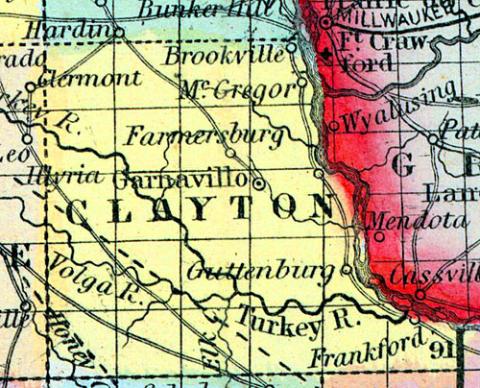GUTTENBURG, a thriving post-village of Clayton county, Iowa, on the Mississippi river, 40 miles above Dubuque. It has a good landing for steamboats. Large mines of lead are worked in the vicinity. (Baldwin's New and Complete Gazetteer of the United States..., 1854)
GUTTENBERG The Town of Guttenberg is pleasantly situated on the west bank of the Mississippi River, about forty miles above DuBuque, and about six miles above the mouth of the Turkey River. The location of the town is on a handsome prairie, extending from the base of the bluff half a mile eastward to the river, and about three miles in length. This prairie received from one of tho early French Missionaries the name of Prairie LaPorte —The Door Prairie.
The village of Prairie LaPorte was probably laid out in 1837 or 1838. Here the county seat of Clayton county was first located. At this time Clayton county was a part of the Territory of Wisconsin. The first term of the District Court of Clayton county was held by Hon. Charles Dunn at Prairie LaPorte, on the 4th Monday of May, 1838, in a log house, the residence of Herman Graybill.
In the year 1843 the county seat was removed from Prairie LaPorte to Jacksonville, now Garnavillo. After the removal of the county seat, all the land and village lots belonging to the county in the village of Prairie LaPorte were sold and conveyed by the County Commissioners to the Western Settlement Society of Cincinnati, Ohio. This Society entered several hundred acres of land contiguous to the town, and employed John M. Gay, County Surveyor, to lay off a much larger town, including Prairie LaPorte within its limits. In January, 1847, the legislature passed an act changing the name of the old town to Guttenberg, and this name was given to the new town in honor of the renowned inventor of the art of printing. The survey of the new town was completed in June, 1847, and about this time considerable improvement was made; but for several years subsequent, owing to the pressure of the times and the paucity of the population of the surrounding country—which was then an almost unbroken wilderness—the growth of the place was not very rapid.
During the session of the legislature in 1850–51, the town was incorporated. At this time the population of the place did not exceed two hundred and fifty or three hundred, and the principal object of the citizens in obtaining a charter of incorporation was to enable the town authorities to impose a tax on real estate, and thus make the large number of nonresident property-holders bear their proportion of the expense of necessary improvements.
The first municipal election was held in April, 1851. Since that time the growth of the town has been onward and upward. Every year has witnessed new and substantial improvements, and a large increase of trade and business.
Since the incorporation of the town large sums have been annually expended in public improvements. Good roads have been made, leading to every part of the surrounding country. The town has an excellent steam ferry boat, which, during the season of navigation, plies regularly between this place and Glen Haven, three miles up the river, on the Wisconsin side.
The buildings are mostly of stone, of which material an excellent quality is obtained from the bluff back of the town.
There are now in the place seven general stores; two groceries; two clothing stores; two hardware, stove and tin stores; two drug stores; three millinery and fancy stores; four blacksmith and three saddler shops; two wagon and carriage shops; one gun shop; three furniture shops; four hotels; 5 breweries; several warehouses; two flouring mills; and one saw mill; together with the usual number of mechanical shops. The Lutheran and Catholic are the leading church denominations.
The commercial advantages of Guttenberg are not surpassed by any town of the same size on the river. It annually ships and receives large quantities of produce and merchandise. The principal articles of export are wheat, flour, barley, oats, corn, potatoes, pork, lard, beef, pig lead, etc.
The country in the vicinity of Guttenberg is beautiful, healthy and remarkably fertile, and is settled with an intelligent and enterprising class of farmers.
The resources of the surrounding country are unsurpassed. Independent of the unrivalled fertility of the soil, it possesses abundant sources of wealth in its vast forests of timber and rich mines of lead ore. North of the town are large tracts of timber for building, fencing and other purposes; while to the south and west the forests extend for many miles, and abound in choice varieties of oak, walnut, hard maple, ash, basswood, etc.
The bluffs immediately back of town abound in lead ore, and on Miners' Creek, within two or three miles of town, several rich veins of mineral have been discovered and profitably worked.
The advantages for manufactures are good. Miners' Creek, in the rear of town, affords - good water power, which has already been rendered available to some extent. The “Big Spring” at the upper end of the town can be made profitable in the propulsion of light
machinery. Steam power can be used to great advantage, and at small cost, owing to the
abundance of timber. With these facilities manufactories could be established and carried
on profitably at this point.
From the bluffs immediately back of town issue numerous springs of excellent water, sufficient in quantity to supply the inhabitants of a large city. (Hair's Iowa State Gazetteer..., 1865)

